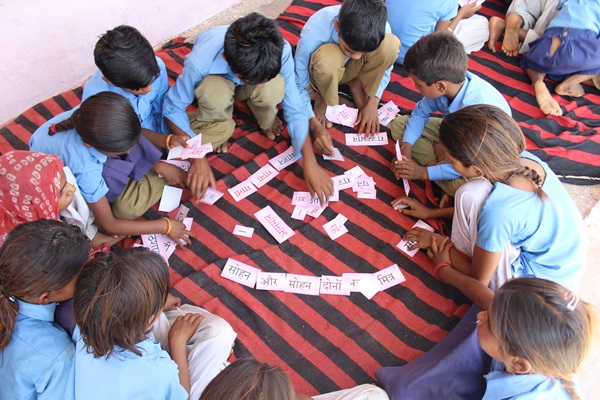Last week Educate Girls and its partners launched the results of the first year of our Development Impact Bond (DIB). For a couple of years now Educate Girls has been on an exciting but challenging journey to test a new financial instrument and deliver the world’s first DIB in education. This bond is a proof of concept at this stage, but, if deemed successful, this new way of financing education has the potential to change the way social sector organizations deliver impact at scale to millions of children across the globe.
The DIB is funding a three-year program that is entirely focused on a set of social impact outcomes – the number of girls enrolled into primary education and students’ progress in English, Hindi and math – all in a remote district in Rajasthan (Bhilwara District, 166 schools, 140 villages, 15,000 girls and boys, 80 per cent of outcomes weighted to learning outcomes and 20 per cent towards girls’ enrolment). After a third of the programme term has elapsed we have already enrolled 44 per cent of all out-of-school girls identified in year one, and have achieved 23 per cent of the total target for learning progress. UBS Optimus Foundation as our investor are providing us with the upfront capital to deliver our work, and The Children’s Investment Fund Foundation are the outcomes funder.
We were delighted to announce that the results so far demonstrate that we are on track to achieve our ambitious 3 years targets for 2018, but what do they really mean for us?
Access to Capital
One of the great hopes for impact bonds is that they might encourage more funding to flow into meeting the Sustainable Development Goals (SDGs) and at the same time improve the accountability of development and government funding. Our investor is already on track to recoup 40 per cent of their investment, so they are a happy partner. We hope that these positive early signs will encourage more private capital to flow into the sector and provide upfront financing for service providers taking on outcomes based contracts.
Accountability to Beneficiaries
For us at Educate Girls our great hope when getting involved in the DIB, was that it will enable us to deliver the highest quality of programme and the deepest possible impact to the ‘4-millionth child’ in our programme. Scaling is a hazardous thing, and ensuring accountability to every child is tough, quality often gets diluted. The reason to go beyond grant funding and take on something as complex as an outcomes based contract was to demonstrate see if its rigor and incentive mechanisms could improve the way we work and ultimately keep us accountable to every child in our programme and so far it seems to be working!
Rapid Course Correction
In the past we generally used field data to feed into the management level of our delivery and adaptions would be made on an annual basis. In the DIB we put data in the hands of our field workers so they know in real time how well they are progressing towards their targets and can take action to adjust their work to improve where necessary. A company is unlikely to wait for an annual review to seek solutions to a drop in profits, however traditionally social sector organizations can be slow to react to challenges in delivery. At the midline evaluation we discovered our field workers were struggling to help the children improve in English and so we were able to identify this and make changes in the curriculum in order to improve our results within the year.
Innovation at the Field Level
At the field level we are really appreciating the fact that our performance is judged by whether we have achieved our outcomes, rather than by whether or not we have delivered on a prescribed set of inputs. We now have the flexibility to innovate, re-deploy staff where they are needed most and take on the activities that we feel will enable us to achieve our outcomes, rather than those committed to in a grant application budget. This is where we are seeing a difference from traditionally managed grant funding.
As an example, in a particularly challenging district where patriarchal customs were proving a real challenge to enrolment, one of our field workers, who had passed her 12th standard at school, took her father along to one or two meetings to help persuade the fathers of out of school girls to allow their girls to attend. The ‘father to father’ conversation worked and the girls were allowed to go to school. In a traditional contract the field worker would have followed an activity plan, that would not have included this creative approach, and those girls may not have been in school as a result. Creative thinking and innovation have been enabled through the focus on outcomes rather than the rigidity of an activities plan rigidly agreed to with a funder.
Learning
There is of course a lot of learning at the partnership level in terms of how future DIBs could and should be set up. Such a complex funding arrangement and partnership approach comes with its challenges, none the least the fact that we had to sign multiple MOUs with the government as well as all the partners in the DIB. This will always be the case, but there should be templates for the next phase which will simplify things enormously.
We very much hope for less onerous verification and testing in our next outcomes based contract. An RCT seemed appropriate for the proof of concept but would not necessarily be required in the next phase.
We are very keen to advocate for outcomes based funding to service providers who may be wary of such an approach, but we are also acutely aware that service providers in future education DIBs will benefit for some pre contract capacity building to improve performance management and implementation. This is something we would encourage philanthropists to consider funding in advance of jumping straight into DIBs. For us this is less than 5 per cent of our budget and outreach and yet at least 30 per cent of our energy. Of course this is not sustainable, but we very much hope all our efforts are paving the way to enable us to reach our wider ambitions for girls’ education and of course help advise what may become an impact bond ecosystem.
It is an exciting but lonely journey pioneering a new concept and to date although there is quite a lot of noise about DIBs, people are still surprised to learn that there are only 2 that have gone into operation – our education DIB and one delivered by the Rainforest Foundation UK covered by Alliance last year. Brookings say there are up to 30 DIBs in discussion across the world and so we very much hope that we can share our learning and perhaps enable future such contracts to benefit from our experience.
Alison Bukhari is the UK director of Educate Girls.
To learn more about the Educate Girls DIB, visit: http://instiglio.org/educategirlsdib/
At the launch event in London, we were involved in an interesting discussion at the the Overseas Development Institute. Watch the discussion here: ODI.






Comments (1)
would like to know about NGOs providing scholarships for higher education to girl students.